Pop up exhibitions hold the potential to provide creative and inclusive platforms for exploration of critically important issues in society, writes Tanishka Kachru.
In recent times pop up exhibitions seem to have become ephemeral and hyper-experimental versions of temporary museum exhibitions that literally pop up and last only for a day or two. Museums have been engaging with communities or hosting groups that do so and the pop ups are usually co-created by all those who turn up and participate.
One such strand of pop ups is connected to interdisciplinary art and design projects that use action research methodology, where the making of the pop up is itself part of an iterative process or sometimes used as a means of representing the process.
I have observed researchers make innovative use of pop ups. Most recently in January 2016 a group of researchers part of UnBox Caravan did a pop up at the Conflictorium (museum of conflict) in the walled city of Ahmedabad that attempted to engage local community around the museum as participants as well as spectators. Another one is a pop up exhibit of a mobile Design Museum Dharavi co-created with a potter’s community by Amsterdam-based curator-artist couple Amanda Pinatih and Jorge Mañes Rubio, in partnership with URBZ, a Mumbai-based urban research collective.
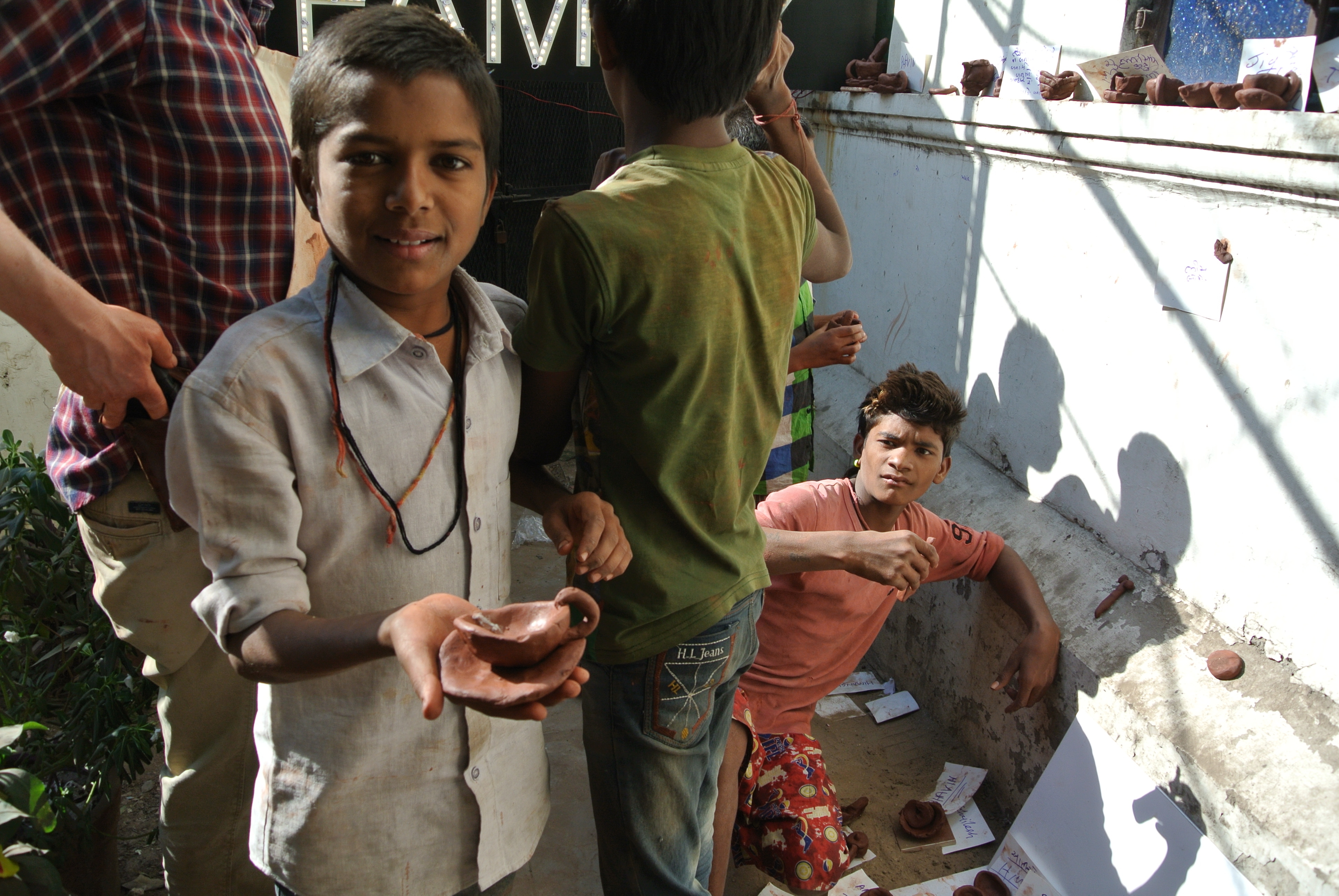 Image: Part of the UnBox Caravan Pop Up at the Conflictorium, ‘finding chemistry’ was a project asking questions about connecting communities of makers across cultural and geographical boundaries.
Image: Part of the UnBox Caravan Pop Up at the Conflictorium, ‘finding chemistry’ was a project asking questions about connecting communities of makers across cultural and geographical boundaries.
In 2015, I was involved in putting together two pop up exhibitions with design students, one in Bangalore, ‘Bengalurina Kathegalu’ (March 2015) and another in Ahmedabad, ‘Future ni Pol’ (November 2015).
Planning the curatorial approach
The Bengalurina Kathegalu pop up came out of a project with students specialising in Digital Design Interactions (now Interaction Design) at the National Institute of Design, Bengaluru. The exhibition was on for two days, including the setup and removal, at the Rangoli Metro Art Center located on the iconic M.G. Road, the heart of Old Bangalore’s commercial-cultural center. The exhibits explored an even older idea of the city that has its origins in the 16th century legend of Yelahanka chieftain Kempegowda (1513-1569). The project started as a conversation with the Kempegowda Museum officials expressing their desire to use digital exhibits in the museum to connect with younger audiences. This seemed ambitious for a museum that currently does not even have its own website.
The student group studied the museum spaces, spending time with curator Krishne Gowda to understand the historical sources used for developing the exhibits. The current museum, located in the historic Mayo Hall building, was setup in 2011. It is clearly aimed at narrating the story of Kempegowda as the heroic visionary founder of the city. It presents this narrative through a static floor map of Bangalore and graphic panels that talk of the chieftain’s lineage, architecture of forts, temples and reservoirs from his time, as well as inscriptions that record events related to him.
The pop up exhibition intended to test the robustness of concepts for exploring the use of interactive technologies, their potential for enhancing museum experiences, and most importantly, their possible role in encouraging social dynamics in exhibition spaces.
Ganesh’s Karaga installation evokes a cultural form and engages visitors in a multisensory experience
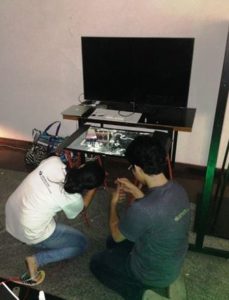
Atul and Arundhati setting up an interactive board game that used arduino and animated storytelling
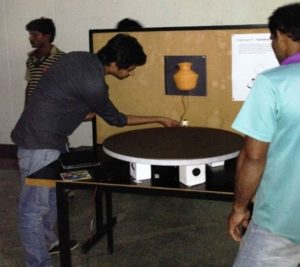
Nakul setting the potter’s wheel in the Pete Pearl hunt installation
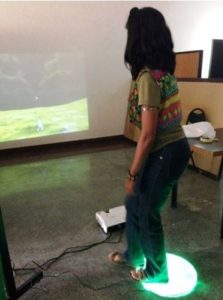
A visitor trying to outrun the dog by jumping on the interactive floor-pod.
A walk in the Pete (market) area with Aliyeh Rizvi of Native Place was the starting point for collecting stories and developing narratives. It turned out to be an important method that helped connect with contemporary lived experiences of the city and communities inhabiting historic spaces shaped by continuous social and political forces. Unlike the singular narrative of the Museum, the student exhibits attempted to reveal this multiplicity and inter-connection of stories about Bengaluru’s origins and its contemporary experience. The stories and legends ranged from the time Kempegowda established the fortress town C. 1537 to the current day celebration of the Karaga festival with the history embedded in the form of its traditional rituals and their spaces.
Executing the vision
The students used simple text labels in English to explain the story of each exhibit. During the pop up I observed that some visitors were curious about the technologies, most (all ages) were interested in the experience, and few engaged in conversations about the multiplicity of stories and the perspectives embedded within them and also shared their own versions of these stories. While initially, the idea had been to test the exhibits with a pop up at the Kempegowda Museum, eventually, the technical requirements of digital exhibits were easier to accommodate at the more modern building of the Rangoli Metro Art Center located within 10 minutes walking distance from the museum. This decision was responsible in bringing in a much more diverse audience and raising awareness about the museum, which is not very well known despite it being located in a prime location.
The pop up’s performative aspect allowed visitors to witness the setup and removal of exhibits so that the technologies were as much on display as the stories. This had a strong resonance with Bengaluru’s current status as India’s technology hub. Understanding the interpretive role of design as a mediator between content and audience was key in planning the exhibition experience.
Living heritage in Ahmedabad
In contrast, the Future ni Pol pop up in Ahmedabad could be seen as entirely performative in its conception, where the act of making and staging the exhibition became a means of starting a dialogue on the future of living heritage environments. This project also started with a walk for students specialissing in Exhibition Design at NID, Ahmedabad. The walk was led by Debashish Nayak, popularly known as the ‘Heritage Man of Ahmedabad,’ who helped the Ahmedabad Municipal Council (AMC) establish a Heritage Cell about twenty years ago.
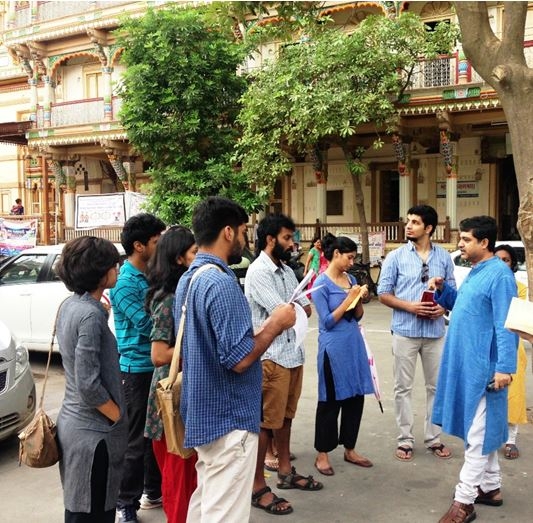 Image: Walking through the Swaminarayan temple in Kalupur with Debashish Nayak the ‘Heritage Man’ of Ahmedabad.
Image: Walking through the Swaminarayan temple in Kalupur with Debashish Nayak the ‘Heritage Man’ of Ahmedabad.
While the walk through the pols (housing system) in the old city gave glimpses of the incredibly rich and textured past lives of these spaces, there were also several signals from the present that provoked the group to think about what lies ahead. If culture is about preservation and continuity of a people (Adichie, 2013) then what do we preserve and how do we choose what continues? This question became the basic premise of the project.
Unlike the interpretive nature of exhibits in the Bangalore pop up, the attempt here was to imagine futures of the pol that respond to concerns of technology, climate change, conflict, and resource depletion expressed by the residents, heritage ‘experts’ and heritage ‘entrepreneurs’. Ahmedabad is perhaps the only city in India to host a Heritage Venture Lab, an incubator for heritage-based start-ups in the newly established Ahmedabad University.
This entrepreneurial spirit of the city and its love of street food was explored through exhibits such as the ‘Gourmandabad’ food stall that served odd combinations embedded with the nostalgia of the past as well as the unpredictability of the future; signs of this can already be seen in the F&B trend of ‘molecular gastronomy’ restaurants. Not surprisingly, around the time of the pop up, Ahmedabad also opened its first such restaurant, amusingly named ‘Nautanki’.
The way ahead
These experiences show how pop ups can be an effective way of testing ideas for design researchers as well as great conversation starters on issues that are integral to our society. Our historic environments (physical and social) are becoming increasingly entangled within the webs of aspirations fueled by technologically mediated lives, making it imperative to address technologies not as passive tools but as configurations emerging from socially situated design and development processes.
What future is probable? What future do we desire? What future is preferable? Pop up exhibitions hold the potential to provide creative and inclusive platforms for exploration of these issues that transcend the kind of polarized debating we witness on television these days.
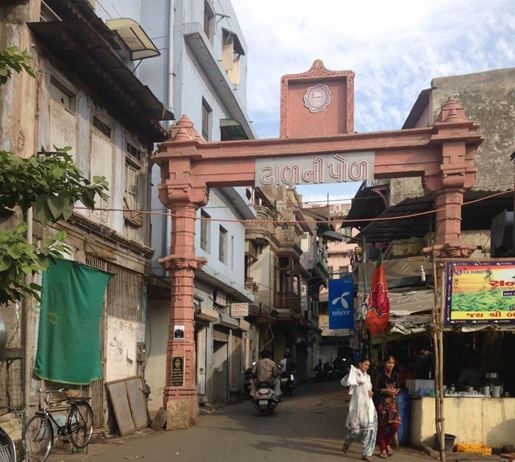 Image: One of the Entrance’s to Dhal-ni-Pol, the second largest and most densely inhabited Pol surviving in the walled city of Ahmedabad.
Image: One of the Entrance’s to Dhal-ni-Pol, the second largest and most densely inhabited Pol surviving in the walled city of Ahmedabad.
About the author
Tanishka Kachru leads the exhibition design specialisation at the National Institute of Design, Ahmedabad. She works with museums on interpretive planning, communication strategies and use of digital technologies. Her research focuses on design histories of colonial exhibitions in India and investigating the idea of nation building embedded in design of exhibitions post-independence.
The National Institute of Design (NID), Ahmedabad set up in 1961, is a central educational institution, autonomous and funded by DIPP under the Ministry of Commerce and Industry, Government of India and declared as an ‘Institution of National Importance’ by the Act of Parliament. NID offers design education, training, research, and consultancy in various disciplines of design through its R&D campus in Bengaluru.








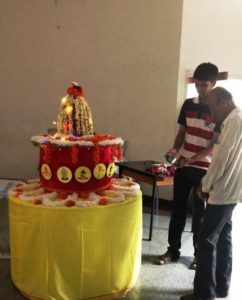
Good article about POP UP Exhibitions. I really like it!!